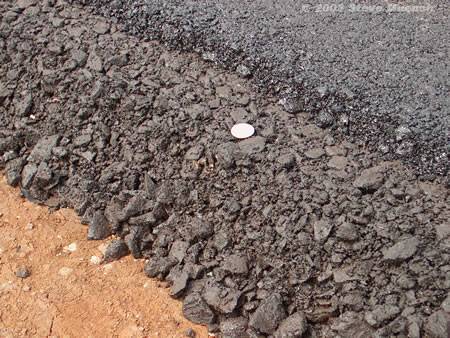Asphalt concrete base (ACB), also called asphalt treated base (ATB), is a dense-graded HMA with a larger nominal maximum aggregate size (1 inch) intended for use as a base course or binder course (see Figure 1). In addition to site paving benefits, ACB can be advantageous because it can provide:
- A waterproof barrier to prevent fines infiltration into the subgrade and pavement structure. If water accumulates in the subgrade, the repetition of pavement loading can cause subgrade fines to migrate into the base and pavement structure. This can clog the base layer, which impedes drainage and create voids in the subgrade into which the pavement may settle.
- An alternative to untreated base material. Structurally, ACB is about three times as strong as an untreated aggregate base. Therefore, it is possible to use thinner layers for the same structural support, which can save on excavation costs. In some cases a layer of aggregate base is still needed to provide material to fine grade and to provide a smooth surface on which to pave.
- A base course that can be opened to traffic immediately after placement. ACB can support traffic as soon as it is compacted. Although an aggregate base may be able to support limited traffic after placement, the traffic must travel very slowly, automobile and windshield damage can result from loose aggregate kicked up by tires, and the aggregate base must typically be regraded and compacted before the final wearing course can be paved. ACB is particularly well-suited for rehabilitation efforts where it is desirable to open paved lanes as soon as possible. Using ACB, a lane can be milled, an ACB base course can be paved and the lane can be opened to traffic while the adjacent lane is worked on. Then, both lanes can be briefly closed while a final surface course is paved over the entire project. This leads to smoother surface courses, better joint construction and can often take only half the time of the same job done with untreated aggregate base material.

The costs savings of using ACB can add up quickly. On a site that must export material (excess cut), an ACB pavement design can save a considerable amount of excavation, hauling and disposal costs. On a site that must import material (excess fill), ACB can be used to build the pavement over more marginal subgrades (i.e., a structure of gravel borrow and ACB can replace thicker crushed aggregate sections).
Important Considerations when Substituting ACB for Untreated Crushed Aggregate Base
- The minimum recommended crushed aggregate base thickness is 4 inches. Substituting ACB for a portion of crushed aggregate is often acceptable, however if any crushed aggregate is to remain it should be at least 4 inches thick.
- The minimum recommended ACB thickness is about 3 inches. ACB gradation and nominal maximum aggregate specifications are quite loose, however pavement layers thinner than about 2-3 times the nominal maximum aggregate size may be difficult to compact, tear under the screed, and rollers may crush the larger particles during compaction.
- Consider the original purpose of the crushed aggregate untreated base. Sometimes aggregate base is needed to provide material to fine grade and to provide a smooth surface on which to pave. In these situations, ACB should not be substituted for crushed aggregate untreated base.
Other ACB Information
- Compacted density is about equal to 1.85 tons/yd3
- Layer coefficient (“a”) for use in the 1993 AASHTO Empirical Structural Design is about 0.35
- Some structural design procedures credit ACB with 95% of the gravel equivalent of regular HMA.
